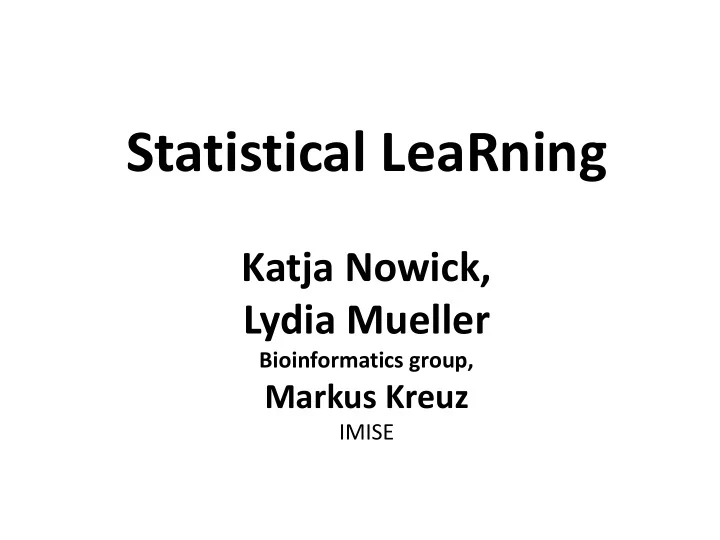

Statistical LeaRning Katja Nowick, Lydia Mueller Bioinformatics group, Markus Kreuz IMISE
What is R? • Programming/scripting language • Comprehensive statistical environment • Strength : statistical data analysis + graphical display
Why use R? • It's free ! • Runs on a variety of platforms including Windows, Unix and MacOS. • Complicated bioinformatics analyses made easy by a huge collection of packages in Bioconductor • Potential to implement automated workflows • Big datasets • Advanced statistical routines • State-of-the-art graphics capabilities
How to obtain and install R? • R can be downloaded from the Comprehensive R Archive Network (CRAN): http://cran.r- project.org/ • Installation instructions depend on your operating system and should be accessible from the R download page for you operating system • For our course, R is already installed We use R-studio as programming environment
~1000 packages in Bioconductor http://www.bioconductor.org/packages/release/bioc/
Binding site detection Finding binding motifs for a transcription factor from a database and draw logo With only 3 lines of code: query(MotifDb, "DAL80") pfm.dal80.jaspar = query(MotifDb, "DAL80")[[1]] seqLogo(pfm.dal80.jaspar)
Quality assessment of NGS data From a directory of FastQ files to a full quality report: @SEQ_ID_1 GATTTGGGGTTCAAAGCAGTATCGATCAAATAGTAAATCCATTTGTTCAACTCACAGTTT + !''*((((***+))%%%++)(%%%%).1***-+*''))**55CCF>>>>>>CCCCCCC65 @SEQ_ID_2 GATTTGGGGTTCAAAGCAGTATCGATCAAATAGTAAATCCATTTGTTCAACTCACAGTTT + !''*((((***+))%%%++)(%%%%).1***-+*''))**55CCF>>>>>>CCCCCCC65 @SEQ_ID_3 With 6 lines of code: files = list.files("fastq", full=TRUE) names(files) = sub(".fastq", "", basename(files)) qas = lapply(seq_along(files), function(i, files) qa(readFastq(files[i]), names(files)[i]), files) qa <- do.call(rbind, qas) save(qa, file=file.path("output", "qa.rda")) browseURL(report(qa))
Finding help • R mailing lists : https://stat.ethz.ch/mailman/listinfo/ • Manuals and FAQs : http://www.r-project.org/ • Selected tutorials : – http://www.math.ilstu.edu/dhkim/Rstuff/Rtutor.html – http://www.statmethods.net/index.html – http://faculty.ucr.edu/~tgirke/Documents/R_BioCond/R_Bi oCondManual.html
Goals for the next 5 x 5 hours Nov 3 rd : Introduction to R Nov 17 th : Statistics and Graphics Nov 24 th : A small programming project Dec 1 st : Analysis of gene expression data Dec 15 rd : Clustering and Gene Ontology
Goals for the first 5 hours R-Studio • R as a calculator (interactive R) • Variables: numeric, character, arrays, vectors, matrices • Loops • Apply • Conditional executions (if-else-statements) • Write your own functions • Multiple exercises in between
Goals for second 5 hours R packages • Help pages • Some more on functions • Graphics • Statistical tests • Multiple exercises in between
Optional for today - If you know already R -
Recommend
More recommend